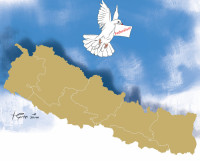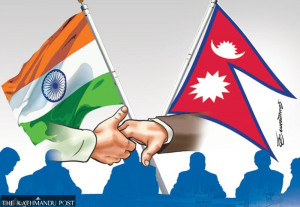Columns
Grassroots democracy in Hetauda
There is an ongoing concern that districts near the power centre are often favoured in budgets.
Khim Lal Devkota
Local governments are often regarded as the backbone of democracy. They are closest to the people and are primarily responsible for delivering essential services. The manner in which these responsibilities are carried out determines a country’s democratic health. In particular, the degree of transparency, accountability and inclusivity demonstrated at the local level strongly reflects the overall strength and vitality of democracy.
Nepal is in the 10th year of constitutional promulgation, which has settled decades of democratic questions and its shape. The country’s departure from the unitary governance model to a three-tier model envisioned local government as one tier with the responsibility and authority to discharge most of the basic services the people need. This participatory and inclusive arrangement of local governments is very inclusive, at least from a gender perspective.
Data suggest that the 2022 election elected more than 40 percent of women representatives to participate in decision-making. This figure is well above that of many mature democracies in the world. However, a closer look at the data suggests that this inclusion is essentially due to constitutionally mandated reservation, and the participation achieved through this is, at best, a tokenistic manifestation. Despite this, some women have risen above the challenges to secure a seat in such a competitive political arena.
Among the many constitutional arrangements, one mandates that the federal budget has to be unveiled by Jestha 15 (May 29), provincial and local budgets by Asadh 1 (June 15) and Asadh 10 (June 24), respectively. Accordingly, local governments present their budget, policies and plans to their councils and conclude this vital task by making new development promises and convincing their councils with plans and policies to achieve development through the budget.
However, the budget cannot be spent without approval from the council. There are legal provisions to penalise local governments that fail to secure timely budget approval from the council. Additionally, local governments are legally mandated to prepare and implement development plans ranging from short-term (periodic and annual) to medium- and long-term, covering specific sectors. These plans must align with the policies, goals, objectives, timelines and procedures set by both the Federal and Provincial governments.
Some local-level plans and programmes are even designed in a way that requires adoption by the provincial and federal governments. Moreover, successful initiatives at the local level often serve as models for replication by other local governments and entities.
A few days ago, I had the opportunity to speak to the members, officials, and concerned groups of Hetauda Sub-Metropolitan City on the city’s development within the federal framework. In the current federal arrangement, Bagmati Province appears to benefit from having Kathmandu within its geographical boundaries. This is evident in how development priorities are set, reflected through budget allocations, expenditure capacities and other development indicators.
Hetauda’s case
Hetauda, a sub-metropolitan city, encompasses interventions that are critical for enhancing the quality of life of its citizenry. It provides clean drinking water up to 10,000 litres of free water monthly to 28,560 households and health insurance to vulnerable families. Similarly, it provides educational scholarships for students to study MBBS. These, put together, form essential components of human capital, an area in which Nepal lags far behind many countries of similar characteristics.
Likewise, the sub metropolitan has created infrastructure that goes beyond conventionally imagined indicators of development (like constructing roads or view towers) and invests in infrastructure such as open gyms, playgrounds and football tournaments for both boys and girls. In a country that frustratingly struggles to find ways to keep its youth in their respective communities, these are interventions that have the potential for youth to find a sense of belonging in their respective communities.
In addition, the sub-metropolitan has created economic opportunities in the agribusiness sector that have generated employment, provided a conducive environment for women’s groups to successfully commercialise products like soybeans, lentils and chips, obtaining necessary licenses and even exporting to international markets. Fruit production—including nuts, dragon fruit and mangoes—has gained access to external markets, boosting local income. These are great leaps forward as they hint at the possibility of localised development, the only way to effectively achieve successful federalism in Nepal.
Mina Kumari Lama served as the Deputy Mayor of Hetauda Sub-Metropolitan City from 2017 to 2022 and has been serving as Mayor since 2022. She is one of the very few women leading urban municipalities in Nepal. Among the 11 Sub-Metropolitan Cities, she is the only woman mayor apart from Renu Dahal, and is part of a mere 7 percent of women who hold executive leadership positions—mayor or chairperson—across Nepal’s 753 local governments. Furthermore, only 11 percent of the elected representatives at the local level, excluding those elected through constitutional reservation, are women. This highlights the significant gender imbalance in leadership, despite Nepal’s otherwise strong constitutional mandates on inclusion.
Hetauda’s relative success in service delivery and local innovation cannot be viewed in isolation. As the headquarters of Bagmati Province and a historically crucial administrative centre, Hetauda benefits from geographic and political proximity to Kathmandu, the federal capital. This privileged location often results in preferential access to development resources. Such patterns are frequently highlighted in policy and political discourse, especially when comparing inter-district allocations. There is an ongoing concern that districts close to the power centre are more likely to receive favourable budgetary treatment.
Recent examples reinforce this perception. For instance, the federal government allocated Rs200 million to enhance Hetauda’s drinking water system by identifying additional water sources. Similarly, under the “Ujyalo Hetauda” programme, 29 high-mast lights were installed in collaboration with the Nepal Electricity Authority (NEA), significantly improving public lighting and safety. These types of federally supported projects illustrate the advantages some districts possess in navigating Nepal’s intergovernmental fiscal landscape.
However, such access to resources alone does not guarantee meaningful progress. What distinguishes Hetauda is how it has attempted to use these resources to strengthen inclusive and participatory governance. The leadership of Mayor Mina Kumari Lama—an elected woman from the Janajati community—in a largely male-dominated political environment is a significant achievement.
Mayor Lama’s tenure also reflects how effective governance can be pursued even without strong partisan backing. She has continued to implement programmes focused on comprehensive local development—ranging from human capital investment to urban infrastructure and livelihood promotion. This suggests that political will, community support, and institutional mechanisms can sustain governance beyond party strength.
As Nepal enters the second decade of its federal journey, the example of Hetauda offers valuable insights into how local governments can translate constitutional visions into practical outcomes. Strengthening grassroots democracy requires not only favourable legal and fiscal frameworks but also bold, inclusive leadership and a genuine commitment to local empowerment. The experience of Hetauda demonstrates that even incremental progress, when rooted in democratic principles, can lay the foundation for broader transformation.




 12.12°C Kathmandu
12.12°C Kathmandu
.jpg&w=200&height=120)












%20(1).jpg&w=300&height=200)

